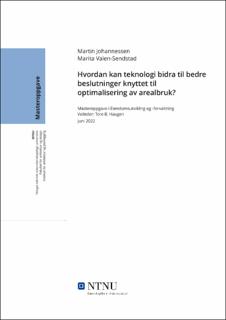| dc.contributor.advisor | Haugen, Tore B. | |
| dc.contributor.author | Valen-Sendstad, Marita | |
| dc.contributor.author | Johannessen, Martin | |
| dc.date.accessioned | 2022-10-12T17:19:27Z | |
| dc.date.available | 2022-10-12T17:19:27Z | |
| dc.date.issued | 2022 | |
| dc.identifier | no.ntnu:inspera:117755407:46529117 | |
| dc.identifier.uri | https://hdl.handle.net/11250/3025695 | |
| dc.description.abstract | Studiens formål har vært å undersøke hvordan man kan benytte teknologi som ett av flere tiltak for å gjøre ledelsen i ulike virksomheter i stand til å kunne ta bedre og datadrevne beslutninger knyttet til optimalisering av arealbruk.
Det er blitt allment kjent at teknologi muliggjør en enklere datainnsamling med større grad av nøyaktighet, for et sikrere beslutningsunderlag. For beslutningstakere og ansatte som jobber med forvaltning av eiendom i organisasjonen blir det viktig å ha kunnskap om bruk av lokalene og endringer i bruksmønster, for å velge rett beslutningsstrategi og ta de riktige avgjørelsene på vegne av virksomheten og hele organisasjonen. For å imøtekomme dagens og fremtidens behov, er det spørsmål om bruk av teknologi kan være en måte for bedre å legge til rette for fremtiden og sikre en mer riktig ressursutnyttelse.
Avhandlingen svarer på problemstillingen:
«Hvordan kan teknologi bidra til bedre beslutninger knyttet til optimalisering av arealbruk?»
Problemstillingen blir besvart gjennom fire forskningsspørsmål som tar for seg noen av de ulike eiendomsteknologiene som finnes på markedet samt erfaringene med disse og hvilke typer data de samler inn. Videre forskes det på hvordan dette, i fremtiden, kan benyttes for å ta bedre datadrevne beslutninger.
For å besvare problemstillingen ble det valgt en kvalitativ tilnærming, da dette ble ansett som mest hensiktsmessig. Det ble gjennomført dybdeintervjuer av leietakere, gårdeiere og domeneeksperter/leverandører. Totalt har 21 informanter blitt intervjuet. Det er i tillegg gjennomført en litteraturstudie som gir innføring i teorier knyttet til strategisk arealbruk, eiendomsteknologi, digitalisering og digital modenhet.
Funnene i studien viser at det finnes mange ulike eiendomsteknologier på markedet, som dekker ett eller flere behov for kontroll og innsikt i bruk av lokalene. Erfaringene fra informantene tilsier at nytteverdien for gårdeier og leietaker kan være stor, men det betinger at man faktisk nyttiggjør seg av dataene og innsikten som eiendomsteknologien gir. Her er det stor variasjon i hvordan dataene i dag blir benyttet videre hos den enkelte informant og hvor godt de har nyttiggjort seg av informasjonen og skapt verdi for virksomheten.
Funnene viser tydelig at data fra ulike typer eiendomsteknologier i fremtiden kan benyttes for å gjøre mer korrekte og optimaliserte tilpasninger av det fysiske arbeidsmiljøet. Kvantitative data som samles inn fra ulike sensorer eller øvrige eiendomsteknologier påvirker beslutninger knyttet til arealbruk, og at påvirkningsgraden avhenger av virksomhetens digitale modenhet for bruk av eiendomsteknologi. | |
| dc.description.abstract | This master thesis aims to investigate how technology can be used as one of several measures to enable the management of various companies to be able to make better and data-driven decisions related to space optimization of the office plan.
It has become widely known that technology enables easier data collection with a higher degree of accuracy, for a more precise decision-making process. For decision makers and employees who work with property management in the organization, it becomes important to have knowledge about the use of the premises and changes in usage patterns. This is to secure the right decision-making strategy and make the right decisions on behalf of the company and the entire organization. To meet the needs of today and the future, the question is whether the use of technology can be a way to better prepare for the future and ensure a more correct utilization of their resources.
The thesis will answer the main research question:
"How can technology contribute to better decisions related to the optimization of office space use?"
The main research question is answered through four research questions that address some of the various property technologies that exist on the market as well as the experiences with these and the types of data they collect. Furthermore, research is being done on how this, in the future, can be used to make better data-driven decisions.
To answer the research questions a qualitative approach was chosen, as this was considered most suitable. In-depth interviews were conducted with tenants, landlords and domain experts / suppliers. A total of 21 informants were interviewed. In addition, a literature study has been conducted that introduces theories related to strategic space utilization, property technology, digitalization, and digital maturity.
The findings of the study show that there are many different property technologies on the market that all cover one or more needs for control and insight into the use of the premises. The experiences from the informants indicate that the usefulness for the landlord and tenant can be great, but it requires that you make use of the data and insights that the property technology provides. Here, there is great variation in how the data is further used today by the individual informant and how well they have utilized the information and created value for the company.
The findings clearly show that data from different types of property technologies can be used in the future to make more correct and optimized adjustments of the physical work environment. Quantitative data collected from various sensors or other property technologies influences decisions related to space usage, and the degree of influence depends on the company's digital maturity for the use of property technology. | |
| dc.language | nob | |
| dc.publisher | NTNU | |
| dc.title | Hvordan kan teknologi bidra til bedre beslutninger knyttet til optimalisering av arealbruk? | |
| dc.type | Master thesis | |
